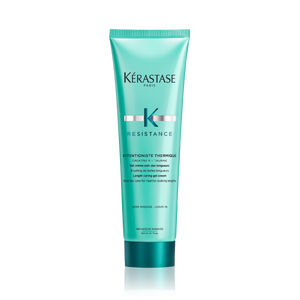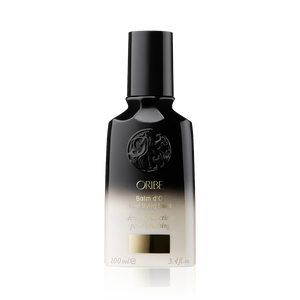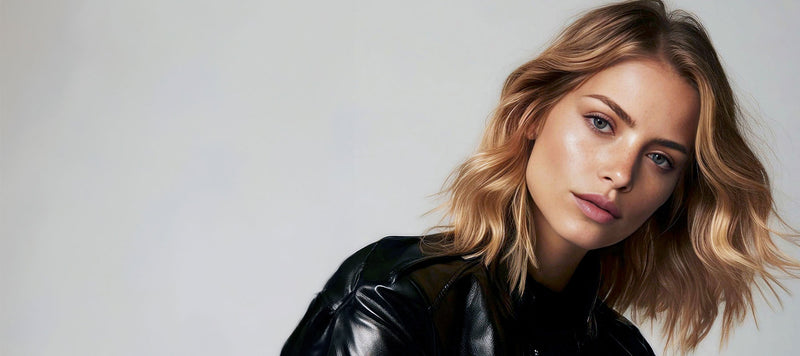Which fringe are you? Fringes to suit every face shape
Getting a fringe is a shortcut to stylish hair and will make you feel amazing - as long as it's the right one for you.
Because there are so many fringe types to choose from - everything from a short, wispy fringe to a full fringe or a block fringe - picking the perfect style can be tricky, even if you've had bangs before.
When choosing the right fringe to go with your haircut, you need to not only have an excellent hairstylist, but you need a good understanding of the fringe and hairstyle that will suit the shape of your face.
"First, you have to decide on the width of the fringe," says Paul Edmonds. "Then how deep you want it cut in - meaning how far back the fringe starts. You also need to look at the hairline, because very often, for people who have something like a cowlick, their life is going to be made more difficult by having a fringe."
If you've decided you're ready for bangs, our expert team at Paul Edmonds London have put together a comprehensive guide on which fringe will suit your face shape so that we can make you look incredible!
Why does your face shape matter when selecting a fringe? Cutting a fringe shape is about creating illusions, and your face shape will determine the illusion you are aiming to create.
For example, with more square face shapes, you may want to create the illusion of roundness, whereas with a long face shape, you might want to use a fringe to disguise your forehead. Of course, it's totally up to you if you want to embrace a trendy fringe rather than decide based on your face shape.
Read on to find out which fringe will suit your face shape best and the answers to some frequently asked questions about fringes…
Fringes to suit a squared face
For square-faced beauties, the style of fringe that will typically suit you is one that isn't too blunt or thick.
"With a square face what you're trying to do is narrow the jaw," says Paul. "It's all about disguising and balancing the face. I recommend going for a narrower fringe, as a wider fringe could make your face look wider. You also need to carefully judge the length of the hair alongside the fringe."
Fringe styles that are well suited for a squared face include having the fringe slightly broken and rounded, as well as having a side fringe.
Both styles will provide a softer look for a square face, particularly a side fringe, which shows off the cheekbones and helps reduce any sharpness around the jaw.
Celebrities with square faces include Zendaya, Margot Robbie, Cameron Diaz and Angelina Jolie.
Fringes to suit a round face
For a rounder face, a shorter, layered fringe is a great style to create the illusion of a longer face.
While we don't encourage a severe 'microfringe' cut high on the forehead, short and wispy 'baby bangs' are great for round face shapes as they will show off your eyes and cheekbones while creating the illusion of squaring off a rounded edge.
Another great fringe for a rounder face is a side swoop which is soft around the edges, but long and wider at the cheek. This will bring depth to the face while being super flattering.
Paul explains: "With round faces, I'd avoid very full fringes or wide fringes because it can make your face look rounder. it's best not to be a heavy, one-length fringe, but something choppy or layered instead."
Emma Stone and Selena Gomez have round faces and always have gorgeous haircuts that flatter their facial dimensions.
Fringes to suit a heart-shaped face
A heart-shaped face suits a long and broken fringe that is swept across to the side from a centre part - but you can also experiment with other styles.
Paul says: "Heart-shaped faces are the easiest ones to decide on a fringe because they've normally got high cheekbones and a delicate jawline so anything will suit them."
A longer fringe brings out your cheekbones and will take the emphasis away from the chin, as a chin on a heart-shaped face is usually more pointed.
Case in point? 'It' girl and pop star Sabrina Carpenter is famous for the blonde 'curtain bangs' that perfectly frame her heart-shaped face.
READ MORE: How to get the Sabrina Carpenter hair look
Fringes for a diamond-shaped face
For a diamond-shaped face, meaning a face that is wider at the cheekbones, anything usually suits. If you have this shape you are extremely lucky as the preferred fringe style is completely up to you.
"You can vary it," Paul says. "You can take a wider fringe or a narrower one, it depends on how you like to wear your hair."
If you want some more guidance with what fringe to have, think about your lifestyle and how having a fringe could impact your day-to-day activities. For example, if you are typically low-maintenance, opt for a broken fringe which can be taken to the side for ease and styling.
Paul adds: "Curtain bangs are still the main look that everyone wants at the moment. The one thing that's being varied is that the centre is being cut into slightly to give a more choppy look."
Take your fringe inspiration from celebrities with diamond-shaped faces such as Jennifer Lopez, Rihanna, Kendall Jenner and Viola Davis.
Fringes for a long face
For you long-shaped beauties, it's worth having fuller and heavier bangs. A chunky fringe gives the illusion of a smaller face, so if you want a fringe style that will shorten a longer face, this fringe style is perfect.
If you don't want to fully commit to a block fringe, you can ask your stylist to break the fringe up slightly, this will give your face the same illusion, without it feeling too boxed in.
"With long faces, you can do a nice full fringe because you're 'taking off' the top part of the face to balance the proportions," Paul explains.
"I think it also looks quite good if you wear it down over your eyebrows, so quite a heavy fringe, but still cutting into it slightly to reduce the general bulk is good because it gives you some adaptability."
Celebrities with long face shapes include Sarah Jessica Parker, Kelly Rowland, Gisele and Liv Tyler.
Fringe FAQs Answered by Paul Edmonds
Paul's team of hairstyling experts have put together their top most asked questions when it comes to fringes…

1. How often should you have a fringe trim?
To maintain your fringe and keep it in good condition, we recommend getting your fringe trimmed every three weeks. Our clients get a haircut every six weeks and pop in for a complimentary fringe trim in between.
2. Should I try and cut my fringe at home, or in the salon?
If you have ever attempted to cut your own fringe you will probably know the answer to that already!
"I've seen many a botched fringe job done at home," says Paul. "You're more likely to be happy and avoid any disasters if you go to the salon for a trim."
All our stylists offer free fringe trims between cuts and we can ensure it is perfect for your face shape and hair texture.
3. Can people with curly hair pull off a fringe?
If you've got curly hair, you can absolutely pull off a fringe, but you must understand the curl pattern.
"It depends on what you want to do, whether it's bringing a few tendrils down so you have a soft fringe, or a heavy curly fringe, which I really like," Paul says.
With our curly-haired clients, we cut the fringe in at a longer length when the hair is wet then allow it to dry and see how the curls shrink. We then trim it again to the correct length.
If you have curly hair and are getting a fringe for the first time, start gently with a subtle shallow fringe and then once your stylist knows how the curls sit, you can be braver with the cut.
For some of our clients with curlier hairlines we also apply our keratin treatment to the fringe only which helps soften the hair.
4. Can people with thin hair pull off a fringe?
If you have thin or fine hair you can definitely pull off a fringe. In fact, the right fringe can revive your look and add freshness to your style.
Your stylist will recommend the best cut to suit your hair texture and face shape, Paul says: "You vary what you do with the fringe, so you may have to bring more hair into your fringe if you've got very fine hair."
Concerned about having fine hair? Our secret to helping you make your bangs look fuller and thicker is beauty supplement Viviscal. Whether you have thin or fine hair, you can combine Viviscal Professional with some simple styling tips to help you create the perfect fringe, no matter what hair type you have.
Alternatively, if you have thin hair you could transform your overall look with extensions. Find out more information about how you can achieve longer, thicker hair in a matter of hours at Paul Edmonds London.
5. What type of fringes are there?
A parted fringe – also called a 'Bardot fringe' or 'curtain bangs', this is where your bangs are parted, usually in the centre and each side is swept away from the face.
A blunt full fringe – is cut sharply and is often thick and heavy, adding definition to your face.
A wispy full fringe – is on the thin side and is perfect for those after something with less commitment and styling.
A rounded fringe – is similar to the full fringe, but has a rounded feel and is longer on the sides blending into the rest of the hair.
Side-swept fringe – a fringe which starts from a side parting and often only covers one half of the forehead. It is usually longer than a full fringe and is very flattering.
Full fringe – A fringe that is combed straight down and is cut vertically across.
Baby bangs - the modern version of the retro microfringe, baby bangs are cut in a choppy style slightly above the eyebrows.
6. Which fringes are in at the moment?
It's all about curtain bangs right now, meaning a long, centre-parted fringe that sweeps softly to the sides like a pair of drapes.
As seen on pop singer Sabrina Carpenter and in hundreds of TikTok before-and-after videos, curtain bangs are the biggest fringe trend we've seen in years and it looks like they're here to stay.
7. How can I protect my fringe from heat damage?
If you're going to be blow-drying your fringe regularly you need to make sure you apply a heat protection product first, such as Kérastase Resistance Extentioniste Thermique Blow Dry Primer or Oribe Balm d'Or Heat Styling Shield to prevent damage and frizz.
8. If I don't like my fringe, how easy is it to grow out?
If you choose carefully in collaboration with your hair stylist, we're confident you'll love your new look. However, if you don't feel your fringe suits you or you find it's too high maintenance, don't worry, it's easy to grow out.
Depending on the length of the fringe, within a few weeks you can begin to sweep it to the side and at your next appointment your hairdresser can help blend it into the rest of your hair.
Paul Edmonds London | The Fringe Experts
Now that you know which fringe styles suit your face shape, have you got a fabulous new look in mind? Maybe you want to try the pop star-approved curtain bangs or a sassy, side-swept fringe?
Book a consultation with our expert hairdressers who will consider your hair type, lifestyle and the latest trends so you can decide on a fantastic fringe that suits you perfectly.
Book a consultation at Paul Edmonds London.




